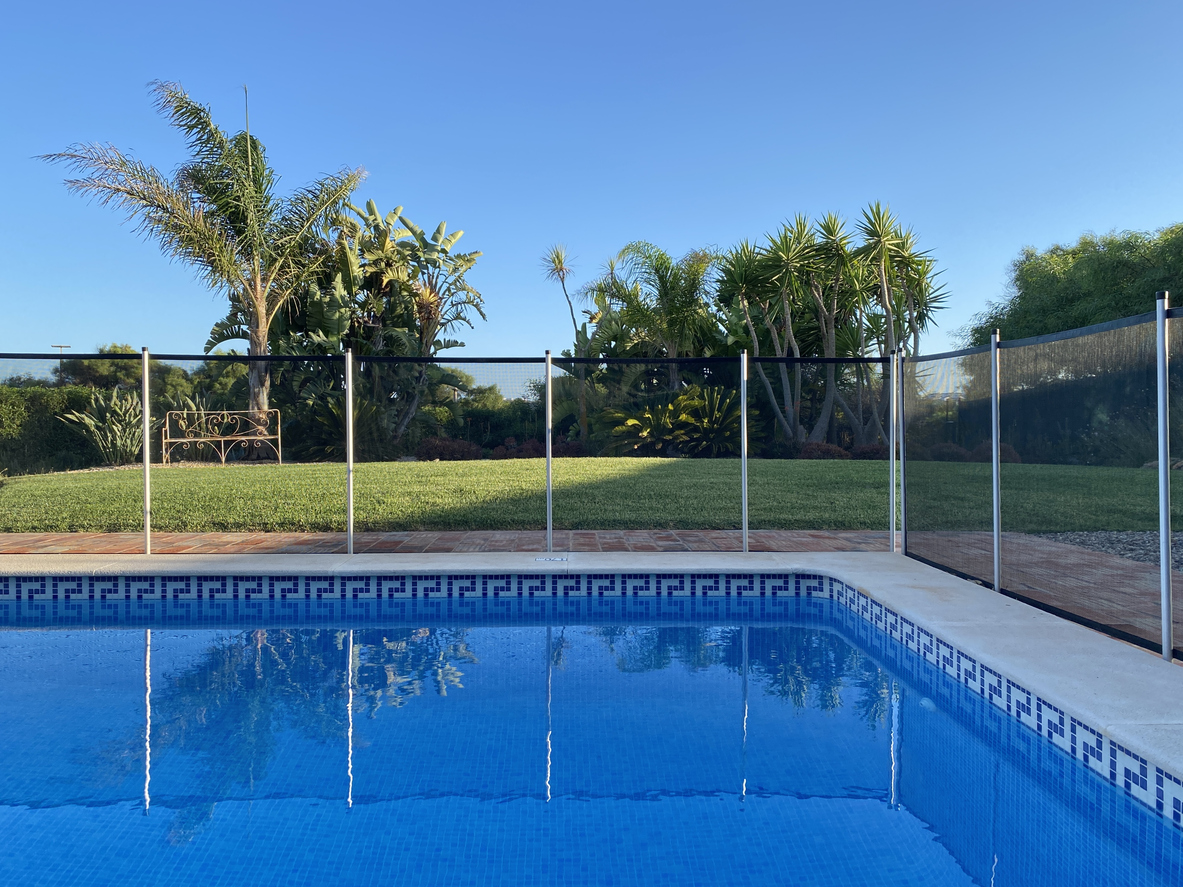

We may earn revenue from the products available on this page and participate in affiliate programs. Learn More ›
Whether you’re at a water park or relaxing in the backyard, diving into a swimming pool is one of the best parts of summer. However, it’s easy to make dangerous pool mistakes if swimmers (and their chaperones) aren’t familiar with basic swimming pool safety tips. Understanding and abiding by safety tips is especially important for groups with kids swimming in backyard pools, as no lifeguard is on duty to watch over the activities.
From safety gear and teaching kids to swim to keeping up with maintenance and installing a security system, here are some water safety tips to understand before diving into a pool.
Basic Pool Safety Guidelines for Parents and Guardians
Above all else, everyone entering the pool needs to know how to swim. Whether that’s a child or an adult, jumping into a pool without having at least a basic knowledge of how to swim is a recipe for disaster. Because of this, parents with a pool in their yard need to prioritize teaching their kids how to swim. Parents who aren’t comfortable teaching the basics will want to consider enrolling their children in a swim class, as an instructor will go over everything required to stay safe while in the water. This includes not just how to swim but other safety swim basics that can keep kids (and their friends) out of harm’s way.
“Drowning is the leading cause of unintentional death for children under 5,” explains Nychelle Fleming, campaign lead for the U.S. Consumer Product Safety Commission (CPSC). “CPSC’s latest data shows that where location was known, approximately 70 percent of pool and spa drownings occurred in residential settings, such as the victim’s home, the house of a family member/friend/acquaintance, or a neighbor’s residence.”
Beyond teaching kids to swim, there are plenty of actions parents can take to improve the overall safety of their swim sessions. For starters, they’ll want to designate at least one adult to be a “water watcher” at all times. These parents are tasked with keeping an eye on the children and making sure they’re safe. Parents can switch off responsibilities so they don’t lose focus, and this ensures there will always be an adult keeping an eye on the children.
Parents will also want to set swimming pool rules, such as no roughhousing, no diving, and no running on wet surfaces. Setting rules in the pool helps keep kids focused on safety and creates guidelines for how parents want them to behave. Pool safety rules need to be a focus of any professional swimming class, though it always helps to reinforce these rules at home.
Once everyone has finished swimming for the day, adults will want to remove all toys from the pool. Toys left in the pool could lure children back into the water—and since no one is monitoring the pool anymore, kids will be left unattended. Clearing out toys and other items from the pool makes it easier to keep children away once pool time has ended. Teaching children swimming safety tips and having vigilant adults present is the best way to keep pool day fun and accident-free.
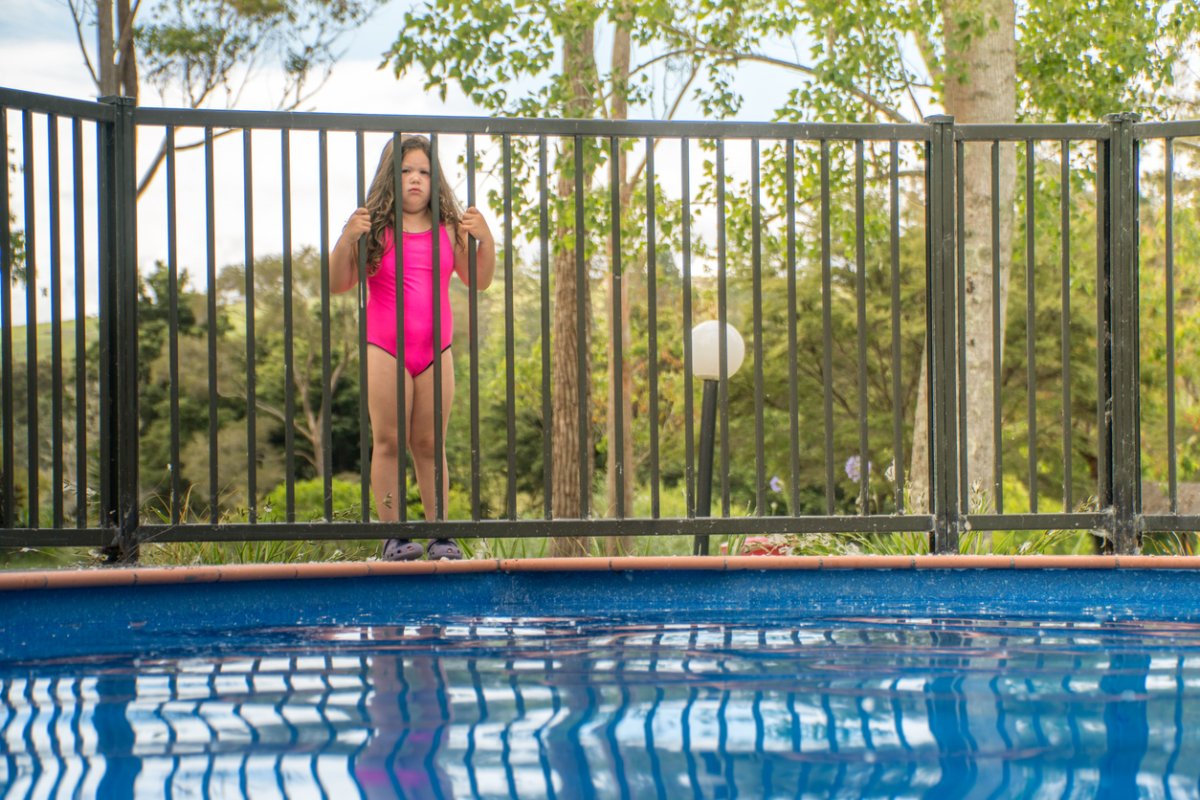
7 Important Pool Safety Tips to Keep Your Summer Safe
Teaching children to swim is the first step to pool safety, but there are plenty of other actions pool owners can take to improve their pool’s security and ensure a fun day in the sun for both adults and kids. Here’s a look at seven other pool safety requirements to help keep summertime fun and improve everyone’s safety in the water.
1. A four-sided containment fence with an alarmed gate can help prevent children and pets from accessing the water unattended.
One of the best ways to keep a pool safe is by installing a containment fence with an alarmed gate around its perimeter. These act as a physical barrier to curious children and pets, ensuring they’re unable to access the pool without adult supervision.
“Kids are drawn to water,” explains Fleming. “One frequently reported drawing scenario is when the child accesses the pool water unbeknownst to the caregivers. Children often drown when they aren’t expected to be swimming or in the pool.”
Containment fences come in a variety of styles and work with both above-ground and inground pools. Above-ground pool fences are typically installed along the top of the pool, with the gate located at the top of the ladder. These make it nearly impossible for a small child to get into the pool unless the door is accidentally left open. Inground pool containment fences look more like traditional fences; they are secured in place around the perimeter of the pool and offer a locked gate.
Many homeowners associations (HOAs) require yards with pools to include a fence around either their entire property or the pool itself. Either way, a containment fence is a wise investment for both safety reasons and to meet the requirements of an HOA.
“The best way to reduce child drownings in residential pools is for pool owners to construct and maintain barriers that will help to prevent young children from gaining access to pools and spas,” says Fleming. “To prevent the child from accessing water, CPSC recommends multiple child resistant barriers. These layers of barrier protection are essential, as they delay the child’s access to the water and allow more time for reestablishing supervision.”
Homeowners can also install an alarm on their containment fence to alert them when the gate is opened. Best of all, many of these gate alarms are easy to use and install. The GE Personal Security Alarm, for example, comes with double-sided tape for easy setup and sounds an alarm if a gate is opened more than a half inch.
The installation of the actual containment fence is another story. Not only do these fences often require a professional install, but pool fence costs can soar above $10,000 depending on the style and layout of the pool. Despite the costs, pool containment fences are a worthwhile investment for the peace of mind they provide. Shoppers living in areas inundated with bugs (such as Florida or South Carolina) may also want to look into pool screen enclosure costs, as screens add a bit of security to the backyard while also keeping it free of pesky bugs.
“[Pool] barriers can include fences with a self-latching and self-closing gate, door alarms for the house (including doors and windows), and a power safety cover over the pool,” Fleming says. “These barriers help keep kids out of the pool when they aren’t supposed to be in it.”
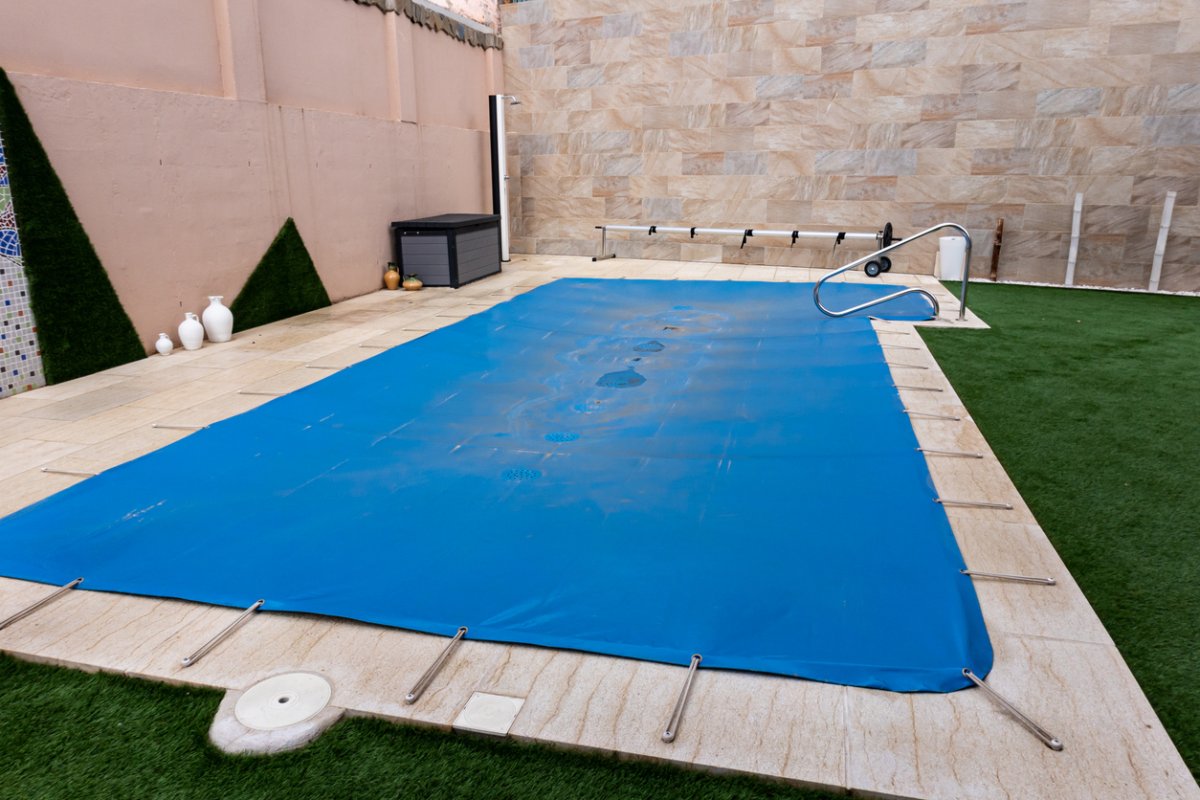
2. An automatic pool cover protects the pool from dirt and debris, and it can also act as a safety device.
Containment fences are a great first line of defense, but they aren’t the only safety device owners can add to their pool. Automatic pool covers are ideal for most inground pools, as they can prevent small children from falling in and also keep out dirt and debris when nobody is swimming.
These types of pool covers come in a variety of styles. If the pool is a standard rectangular shape, an automatic pool cover can be installed directly inside its perimeter. This type of cover takes up relatively little space, yet it protects the pool from gathering leaves and other debris that can impact its water quality. More importantly, a pool cover can prevent children from falling in.
Pool owners will want to keep in mind that pool covers are made with different types of materials and offer different levels of durability. For a cover to prevent children from falling in, it’ll need to be thick and offer several layers of reinforced materials. Otherwise, the cover won’t be able to withstand the weight of a child.
Pools that are oddly shaped can still make use of pool covers, though they’ll either need to be custom-made for the pool or installed over the top of the entire pool. Both options are useful as a safety device, though it’s important to ensure there are no crevices or openings where a child can sneak underneath the cover. Automatic pool covers cost as little as $7,000 to well over $25,000, so owners will want to shop around to find the best deal if they’re working with a budget.
Pool owners may also want to look at the best solar pool covers, which help keep the water warm during cooler days. However, they may not be as protective as an automatic pool cover.
3. A pool alarm can alert you to a child or pet entering the pool so you can act quickly.
Pool alarms are a great last line of defense, as they let owners know when a child or pet has entered the water. These small devices don’t take up much space and are easy to install, allowing them to be set up without the need for a professional.
Though they come in various styles (and are suitable for both above-ground and inground pools), the best pool alarms are designed to detect when people (or pets) get in the water. Many provide details on what size object will set off the alarm, allowing users to find one that fits their needs. The Poolguard PGRM-2, for example, will trigger an alarm if anything similar in size to a 1-year-old enters the pool. The alert is then sent to a remote receiver to set off a loud siren, which can be placed up to 200 feet away.
Most pool alarms are always on and feature tamper-proof housing. So once they’re installed, they’re difficult for a child to remove. It’s important for homeowners to keep in mind that pool alarms won’t prevent people and pets from wandering into the water. Instead, they’re built to alert families that something has already entered the pool. Because of this, pool alarms need to be paired with features like containment fences and pool covers for better protection.
4. Anti-entrapment drain covers help prevent small children and pets from being sucked into drains—and in some areas, they’re legally required.
Anti-entrapment drain covers are designed to keep swimmers safe from the powerful suction found on drain lines at the bottom of the pool. These drain covers don’t inhibit the flow of water, but they do prevent people and objects from getting trapped due to the intense suction created by the drain line.
These raised covers can be easily installed over the existing drain to help limit the amount of suction they create. They’re typically rounded and raised slightly off the surface of the pool, which helps to reduce the drain’s power and ensure a safe swimming environment for everyone. Pools with a flat drain cover usually won’t do much to prevent entrapment, making it crucial for homes to upgrade their gear as soon as possible.
“Consumers also should check to make sure their drain covers are ‘safe drains,’ meaning they are compliant with the Virginia Graeme Baker Pool and Spa Safety Act,” explains Fleming. This act went into place in 2008, requiring commercial pools and spas to use anti-entrapment covers. Many jurisdictions have since rolled out similar laws for residential pools, so owners will want to pay close attention to the requirements for their area. Even if an anti-entrapment cover is not legally required, homes with small children or novice swimmers will want to strongly consider installing one to improve the overall safety of their pool.
“If consumers don’t know if they have compliant drain covers, they should ask their pool service representative,” Fleming advises.
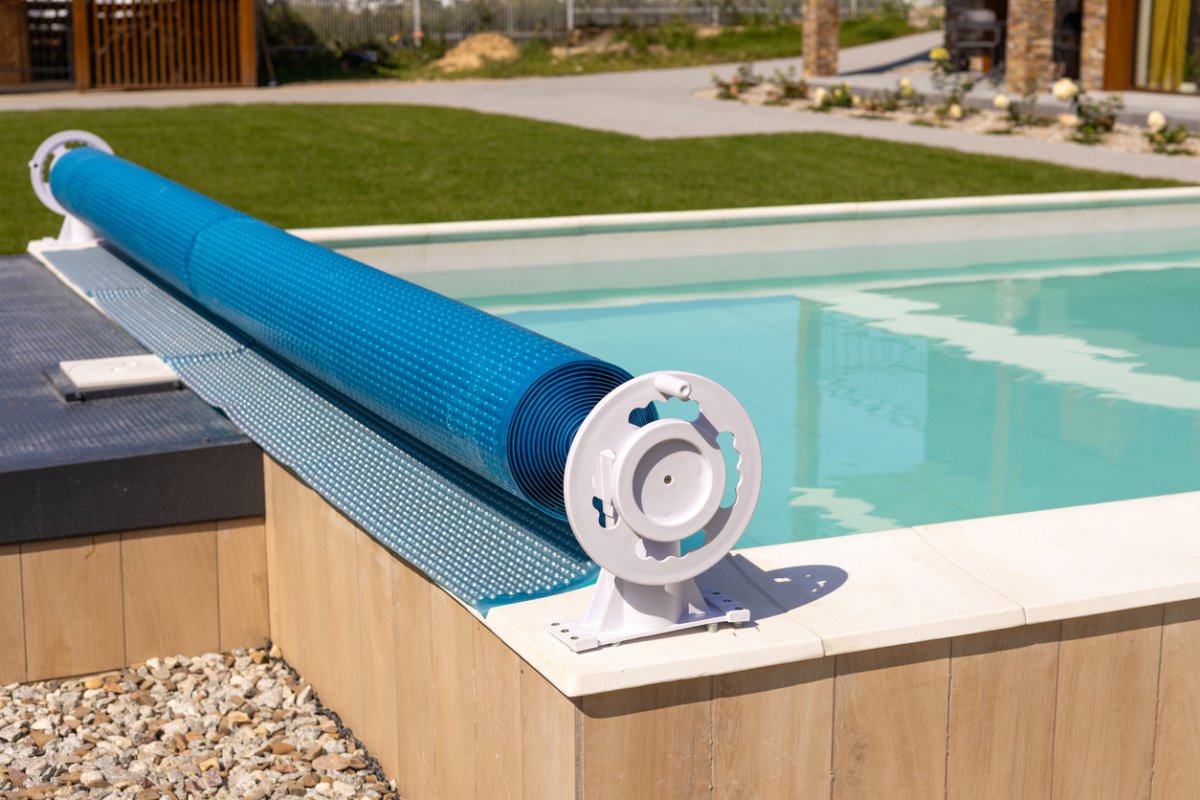
5. Removing or securing steps and ladders on above-ground pools prevents them from being accessed when not in use.
Aside from adding safety gear like containment fences, anti-entrapment drain covers, and pool alarms, there are several habits pool owners can develop to keep their pools safe. One of the easiest things to do is remove ladders from above-ground pools when they’re not being supervised.
“After use of a larger above-ground pool with ladders, the ladder should either be removed or use the child resistant feature,” recommends Fleming. “This is important after each pool use.”
Most above-ground pools feature a removable ladder that leads swimmers over its large retaining wall and into the water. Many of these ladders are not permanently installed, meaning owners can reposition or remove the ladder as they see fit. A simple way to keep small children out of an above-ground pool is to simply remove the ladder and lock it away in a shed or other secure location.
If the above-ground pool is surrounded by a deck, homeowners can consider installing a gate to the stairs. The gate can then be locked like one on a standard containment fence, preventing easy access to the pool.
Unfortunately, there aren’t any reliable ways to lock down an in-ground pool. Since swimmers can simply walk up to the water and dive in, there are usually no ladders to remove or any viable way to lock down the steps leading into the pool. This makes containment fences and pool covers extra important for inground pools.
6. Keeping up with regular pool maintenance can help ensure your pool safety equipment is functioning properly.
Pools require frequent upkeep to continue running at optimal levels and to ensure their water quality is safe for swimmers. But beyond being useful for overall pool quality, regular maintenance is one of the best ways to ensure all installed safety equipment is functioning as intended. Pool maintenance costs vary widely depending on whether a professional is hired or the maintenance is handled in a DIY manner, but no matter the cost, it’s the best way to keep a pool running like new and ensure its safety.
Skimming the surface of the pool can help prevent debris from setting off alarms. Checking on pool covers ensures they’re still capable of rolling out over the entire pool, and entry sensors can be tested to see if they’re sending accurate alerts. Mechanical checks aside, regular pool maintenance such as chemical checks will prevent the water from harboring bacteria that could cause illness to swimmers.
Understanding how to maintain a pool is vital to keeping it safe. Owners who need more guidance on the subject can consult the company responsible for the pool’s installation. It’s also a good idea for homeowners to read up on the CDC’s guidelines for keeping a healthy and safe residential pool. This includes tips on how to treat water and how to properly handle chemicals and also guidelines parents can pass along to their children on how to behave before diving in. In other words, it’s a great resource on how to improve all aspects of safety in a swimming pool.
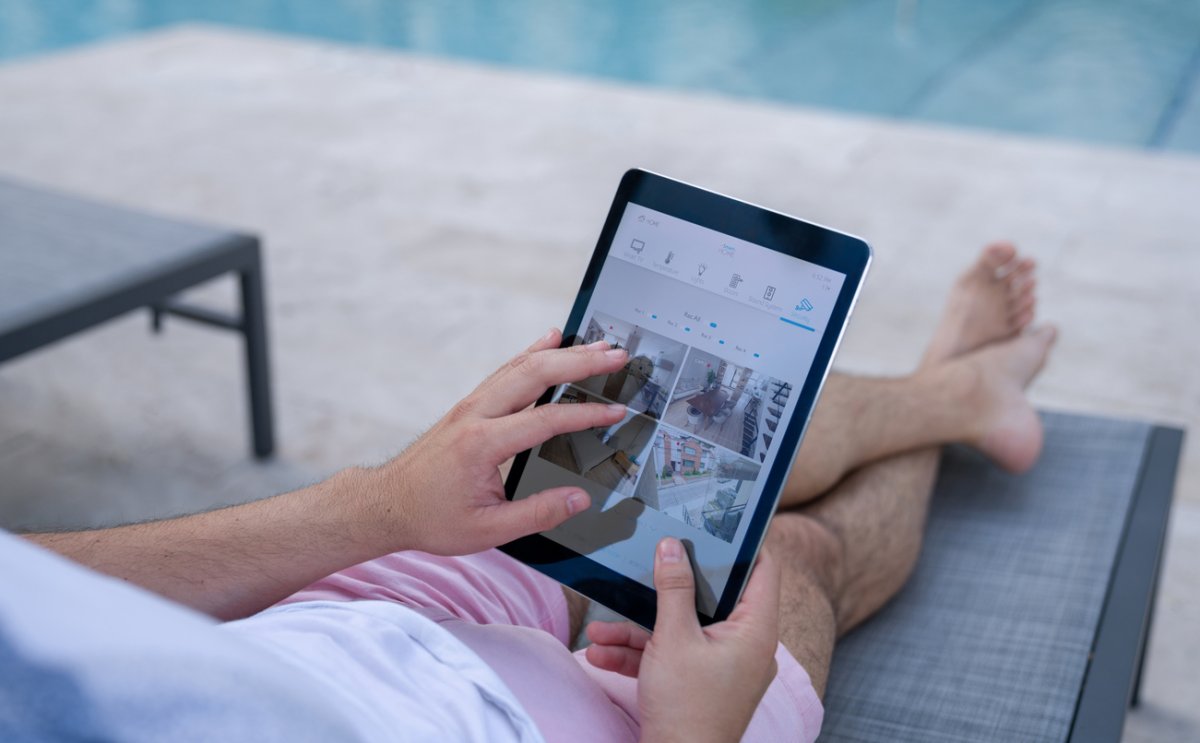
7. A home security system with exterior cameras can help you keep an eye on the pool day and night.
Homeowners looking for additional ways to improve pool safety will want to look into installing a home security system with exterior cameras. Not only will these help owners keep tabs on who is in, around, or approaching their pool, but it lets them know if strangers or unwanted guests are lingering around their property.
When properly installed and customized, most exterior cameras allow users to set up motion zones that will trigger an alert when something moves into a certain section of the yard. For homes with pools, that means it’s easy to create a system that sends push notifications to a smartphone the instant someone gets near the water. This allows exterior cameras to serve as a nice backup to containment fences, pool alarms, and pool covers.
Exterior cameras are also a great way to see exactly who is getting close to the pool. Most of the pool security equipment detailed above doesn’t record any footage, so there’s no way to review what actually happened around the water. Security cameras can fill in the blanks, allowing users to see the steps leading up to how someone accessed the pool, which in turn can be used to further enhance its security. The best home security systems (such as a system from Vivint or ADT) include cameras as well as motion detectors, entry sensors, video doorbells, and more, making them a well-rounded companion to other pool safety devices.
